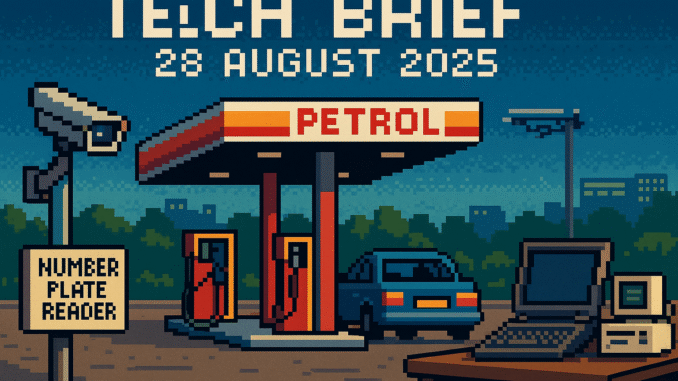
Tech Brief 28 August 2025 opens with sharp edges, not recycled nostalgia. Fuel crime is up, digital policing is stuck in a rut, and the fallout from the Post Office scandal lingers. If you find government IT promising clarity while quietly tripping over itself, you’re in familiar territory. Missed yesterday’s Tech Brief? Catch up here before diving in.
Petrol Theft Tech: Why Britain’s Independent Garages Won’t Just Stand By
“Drive-off thefts are now nearly a third of petrol station crime,” according to recent British Oil Security Syndicate research. This isn’t a headline from 1988; it’s the reality facing independent garage owners in 2025. Tired of corporate systems that cost a fortune or don’t quite fit, many are installing their own homegrown solutions, from custom number plate readers to motion-triggered alerts and integration with old forecourt CCTV. That entrepreneurial streak reminds me of the do-it-yourself energy that built the UK’s home computer scene.
There’s a certain satisfaction in seeing a local garage owner tweak a setup themselves. One hand on a battered ThinkPad, another holding the kettle. It’s a real test of British tech improvisation, but also a glimpse of community-driven innovation that still has teeth. Is it perfect? Not by a long shot. If you want to see the spirit of ’80s microcomputing alive, just watch a garage legend patch together an answer out of basics and bravado.
Strategic Restructure at Police Digital Service: Same Story, New Line-Up
What happens when a public sector tech project sours? In the UK, it seems you reshuffle senior management and hope accountability follows. The Police Digital Service has announced a string of interim leadership hires after two staff members were arrested for suspected misconduct last year. These shifts come as yet another reminder that Britain’s digital transformation in public services just loves to bang its head against the same old wall.
For anyone who worked through the Passport Agency crash in 1999, this story will feel grimly familiar. There is some comfort, odd as it sounds, in seeing this pattern repeat. The government’s big IT dreams have been collision-testing reality since the dot-matrix printer days. Each new round of “change management” is greeted with hope, then met by the same obstacles: budget overruns, off-the-shelf software that does not play nicely, confusion over who is actually in charge.
Post Office Scandal Ties Fujitsu to Home Office Tech: Questions Grow
How tangled can technology contracts get? Fujitsu, still under a cloud over the Post Office Horizon IT disaster, is now providing police investigation network services while also seeing ex-staff investigated by the same authorities. It is the sort of twist that would be farcical if so many lives had not been upended by the original scandal. National infrastructure runs through vendors with long historic ties, even as scrutiny ramps up.
This story is tightly woven into the one above. The Police Digital Service operates in the shadow of unresolved trust questions. As the Home Office leans on the same tech giants time and again, it raises the risk of conflicts of interest, real or perceived. For British tech culture, it is another painful lesson. Promises of digital improvement can quickly sour when accountability lags behind capability.
Would it be easier to rip it up and start again? Or do these familiar names, for all their failures, form the digital backbone too deeply to pull free? That’s an open question, and there’s no tidy answer.
From the Wayback Machine
On This Day: 1989, the UK’s first ISDN (Integrated Services Digital Network) call was made, turning copper lines into digital highways. ISDN meant two 64Kbps channels for voice and data side by side, and call setup dropped from over ten seconds for dial-up modems to less than a second. BT rolled out the backbone, while early adopters like BP got first dibs. In the early 90s, ISDN became the cautious techie’s best route to reliable digital communication. Prices fell, uptake rose, and for a brief spell, “digital” did not just mean the calculator on your desk. Today, ISDN’s bones still sit under modern networks even as we chase more speed and fibre dreams.
What This Means
Tech Brief 28 August 2025 reminds us that history, especially in British tech, rarely clears the slate. Grassroots fixes thrive, big institutions turn slowly, and vendors’ reputations linger longer than modems on a noisy line. Nobody likes a clean ending, especially not here.
Stay curious, stay awkward, and if you’re wiring up your own fix this week, own every solder burn.
Missed yesterday’s Tech Brief? Catch up here

Leave a Reply